According to Swedes, Skansen (pronounced skawn'-sin and rhymes with Wisconsin, so long as you say Wisconsin like a Wisconsinite, as was one of my college roommates), is the first open-air museum. But I think every country says their open-air museum is the first! I had always wanted to visit Skansen but due to the pandemic, it was closed most of the time we've been here. It opened in the summer, but I was loathe to visit, given the crowds of people that would be there. So finally . . . in October, we went to spec it out to see if we thought our daughter Michelle and her husband Andy would enjoy seeing it when they came in November. But . . . even though Skansen is supposedly open all year long, many of the buildings were closed in October, so we decided people really ought to see it in the summer. It actually is an amazing place and could easily take up a whole day if your feet could stand it. Be sure to click to enlarge and click to watch the videos.
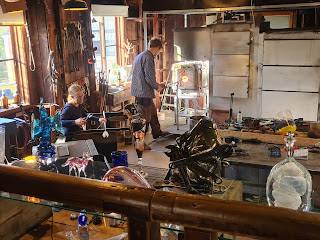 |
| The glass blowing shop was the first one we visited. So interesting to watch them at work. |
 |
| And can you imagine doing it in the heat of the summer? July was very hot even though the temperature was only in the 80's. |
 |
| Amazing what you can make with glass. |
 |
| Outside the glass place the ground was covered with broken glass. What a fun place for children to play! Ha ha. Looks so interesting, but be careful! |
 |
| LeRon's favorite place, of course, was the machine shop. As you can imagine, we spent a lot of time here. LeRon has happy memories of working with his dad in the shop, and then working with his sons. He's excited to go home and see the huge new shop our sons have built in our absence. |
 |
| He explained how all these pulleys work but I can't remember any of it now. But I took several videos of him explaining everything. They are below. We thought our sons and daughters and grandchildren may find his explanations and memories interesting. |
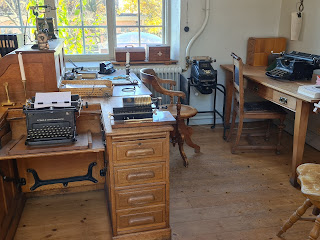 |
| I found the machine shop office interesting. I used to type on a typewriter like the one on the desk. Typewriters and computers have definitely come a long way, but at the time, these typewriters were amazing. |
 |
| This restored home was so fun! You could actually sit on the couches and play the piano. This piano was in remarkable shape for having been built in 1850. Listen to the video below. |
 |
| Interesting arrangement of the strings. Maybe LeRon will tell us more. |
 |
| The docents were dressed in period costumes and were happy to tell us all about life in one of the more prosperous families. |
 |
| Visitors were encouraged to touch and sit and feel. So nice to do more than just look. |
 |
| A peek into the birthplace of Artur Hazelius who was the founder of the Nordic Museum and of Skansen Open-Air Museum. He was born in 1833 in this home. Inside are his personal belongings and furniture from his later home. |
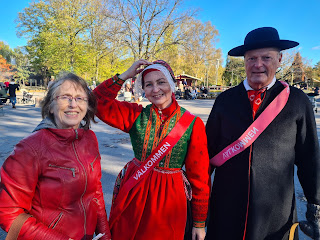 |
| Welcomers in period costumes were happy to give advice about what to see. It was a cold, windy day. |
 |
| You can also bring your own korv (sausage which is so popular here) and cook it over a fire. |
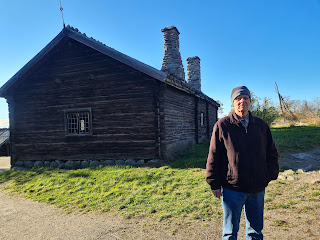 |
| Several old farmsteads drew our attention. |
 |
| These buildings are in amazing shape for as old as they are. |
 |
| LeRon was interested in the way these buildings were constructed. |
 |
| Twigs were used to tie the logs together. People back then used whatever they had and made do with so little. |
 |
| Another home . . . |
 |
| with a spinning wheel |
 |
| They decorated their homes with wall hangings and made it pretty comfy. |
 |
| The docent is keeping warm by the fire. |
 |
| Beautiful old clock and wardrobe |
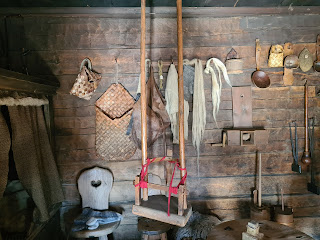 |
| and a baby swing for the baby |
 |
| and a toy horse for the toddler |
 |
| Believe it or not, this is a musical instrument that still works. |
 |
| I took this picture to remind myself that the women wove yarn into wool and then they washed it in cold water until it was stiff like felt. On the left is the original wool and on the right is the felt fabric that it has become after washing and scrubbing it. |
 |
| I can't imagine weaving yarn into fabric! |
 |
| Rune stones were erected as memorials to close family or to mark important events. This one was carved by Åsmund Kåresson. It says, "Björn, Ödulv, Gunnar, Holmdis erected this stone in memory of Ulv, Ginnlög’s husband. And Åsmund carved it." |
 |
| The Främmestad Windmill comes from a farm in Västergötland. It was built in 1750. "Above the millhouse is the wheelhouse which supports the sails. This can be rotated to meet the wind. The motion of the sails is transmitted through shafts and gears to the upper millstone in the millhouse where the corn is ground. The wheelhouse is rotated round a wooden drum using a pole. There have been mills like this in Sweden since the 17th century." |
 |
"This cottage shows how two families of farm labourers lived about the year 1920. Farm labourers were hired on the larger estates for one year at a time. They were housed and received a ration of food from the estate. They had a plot of land for growing potatoes. The labourer's wife was obliged to milk the estate cattle. Even the children had to participate. This system of farm labour, which started in the 18th century, was abolished in 1945."
|
 |
| There are many bell towers in Sweden. This Hallestad Belfry is 40.5 meters tall and is the tallest in Sweden. It was built in the 1730's and was donated to Skansen by parishioners after their church was destroyed by fire. Belfries were commonly built of wood, but this was "forbidden" by the middle of the 18th century to save timber and to reduce the risk of fire. |
 |
| I almost convinced myself to go for a ride on this carrousel. I've never done it but someday I'm going to. Lots of fun rides for the kids. |
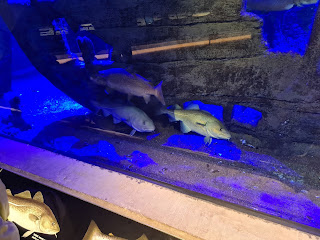 |
| And then a building housing aquariums. And in the 5 hours we were at Skansen, we saw only a fraction of what is there. If you ever come to Sweden in the summer, be sure to see Skansen! |





































0 comments:
Post a Comment